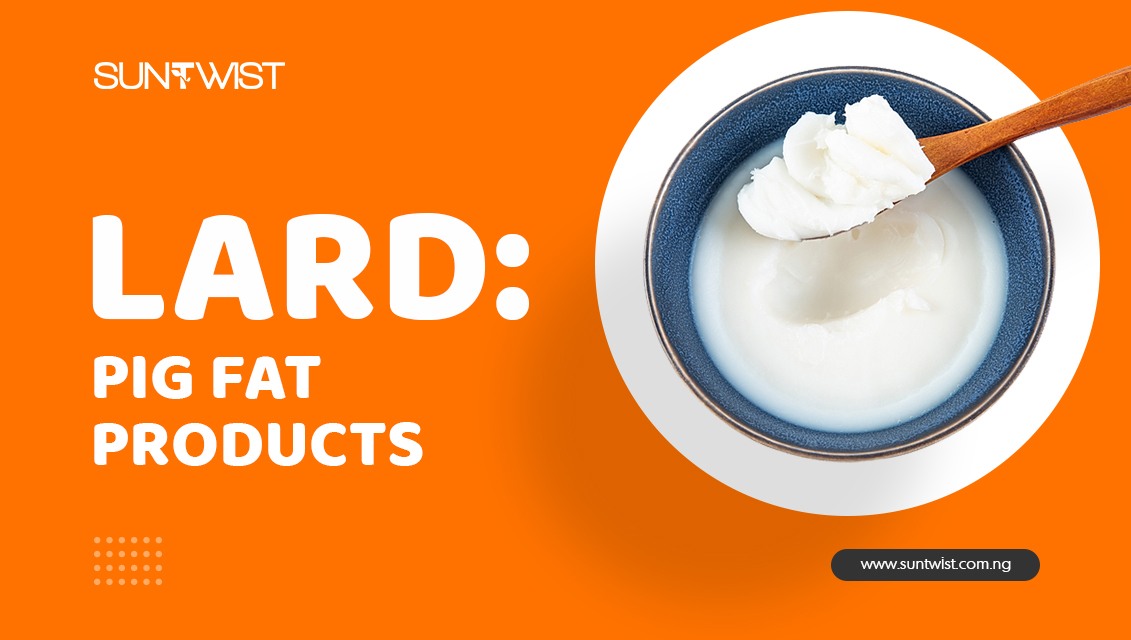Ever heard of Lard?
Don’t rack your brain thinking what it is, we’ve got you.
What Is Lard?
Lard is a semi-solid white fat product obtained by rendering the fatty tissue of the pig with no trans-fat and a high value of fatty acid in it. It is a source of linoleic acid, which is an important fat for our body’s inflammatory response, which is an omega 6 fatty acid.
Lard may be rendered by two processes:
- Wet rendering
- Dry rendering
Wet rendering:
In wet rendering, pig fat is boiled in water or steamed at a high temperature and the lard, which is insoluble in water, is skimmed from the surface of the mixture or separated in an industrial centrifuge.
Dry rendering:
In dry rendering, the fat is exposed to high heat in a pan or oven without water (a process similar to frying bacon).
The two processes yield somewhat differing products. Wet-rendered lard has a more neutral flavor, a lighter color, and a high smoke point. Dry-rendered lard is somewhat browner and has a caramelized flavor and has a lower smoke point. Lard varies with the production method and the fat-bearing animal parts used.
It is different from tallow, a similar product derived from fat from sheep or cattle.
Steam or wet-rendered lard is made by injecting steam under pressure into a closed vessel containing hog fats.
Open-kettle-rendered or dry-rendered (enclosed-system) lards, which are darker in color, are made by melting hog fats in steam-jacketed vessels; the residue is called cracklings.
Neutral lard is prepared by melting leaf fat (from around the kidneys) and back fat at about 49° C (120° F).
Continuous rendering involves grinding, rapid heating, and the separation of fat from the cells by centrifuging.
Lard composition varies with the diet of the hogs. The predominant fatty acids are oleic, palmitic, stearic, and linoleic.
Lard can be obtained from any part of the pig that has a high concentration of fatty tissue. The highest grade of lard, known as leaf lard, is obtained from the “flare” visceral fat deposit surrounding the kidneys and inside the loin. It has a little pork flavor, making it ideal for use in baked goods, where it is valued for its ability to produce flaky, moist pie crusts.
Lard’s smoke point is high, about 375˚F, sources say, making it the ideal frying oil, offering lighter, fluffier, flakier, and crispier battered chicken and pie crusts fried in a shorter time, without burning.
What is rendering?
Rendering can be defined as the process used to extract lard from fatty tissue. To perform rendering, the fatty tissue of the pig is heated slowly until the fat turns into a melted liquid. The liquid fat can be separated from the solids and used for cooking. Rendering is easy to do at home and only requires a fatty cut of pork and a dependable pot or pan.
Uses of Lard
-
Baking
Bakers treasure particularly “leaf lard,” that rendered from the fat adjoining the hog’s kidneys and abdomen as a shortening in pastry dough and pie crusts, used to produce a flakier, more tender confections. Lard’s coveted performance in such desserts stems from its good-sized fat crystals, which lend a grainy edge to the texture of the baked goods.
-
Seasoning Cast Iron
Lard is a fine choice for seasoning cast-iron cookware, maintaining a nonstick and protective sheen.
-
Soap
Lard has been used in soap-making for centuries. Producing a moisturizing lather. The fat is often combined with other kinds of oils to bolster its cleansing properties.
-
Cutting Oil
Machinists use it as a cutting oil to lubricate and cool bits and work-pieces, as well as to ward against rust.
-
Cooking Oil
Because of its stability, its high smoke point (which approaches 400 degrees Fahrenheit), and its special flavor, It is a highly favored oil for frying.
-
As a spread
It is at times substituted for butter, like spreading it on bread. In many fine diners, it is provided as a spread with bread.
Nutritional value of Lard
It has been known to be better than butter because of its fatty acids.
Where can I get Lard?
Pork lard that you find at the grocery store is hydrogenated and filled with preservatives and chemicals. This means it will have a longer shelf life but contain less vitamin D so it becomes very important to find pork fat from a farmer and render it yourself.
Lard is a source of linoleic acid, which is an important fat for our body’s inflammatory response. It is an omega 6 fatty acid most North American diets get too much of. The quality would depend on a pig’s diet. As omnivores, swine eat everything from mice to worms to grain to grass.
Since you’ve got an idea of what Lard is, so you can go down to any grocery store and get one for yourself or better still, locate a farm that rears and processes pork in order to get the fat so as to render it yourself. Spread it on your bread, use it to fry whatever you want, etc.

